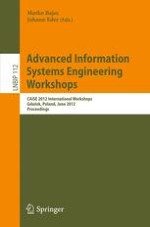This book constitutes the thoroughly refereed proceedings of eight international workshops held in Gdańsk, Poland, in conjunction with the 24th International Conference on Advanced Information Systems Engineering, CAiSE 2012, in June 2012.
The 35 full and 17 short revised papers were carefully selected from 104 submissions. The eight workshops were Agility of Enterprise Systems (AgilES), Business/IT Alignment and Interoperability (BUSITAL), Enterprise and Organizational Modeling and Simulation (EOMAS), Governance, Risk and Compliance (GRCIS), Human-Centric Process-Aware Information Systems (HC-PAIS), System and Software Architectures (IWSSA), Ontology, Models, Conceptualization and Epistemology in Social, Artificial and Natural Systems (ONTOSE), and Information Systems Security Engineering (WISSE).
